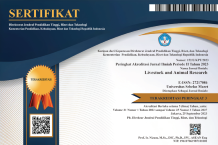Nutritional quality of fermented feed for local chicken containing banana tree waste in Sidolego Village, Tabir Lintas District, Merangin Regency
Abstract
Objective: This study aims to determine the nutritional quality of fermented feed containing banana plant waste that will be given to native chickens in Sidolego Village to accelerate the achievement of Sidolego Village as a chicken center village.
Methods: The ingredients used to make fermented feed were banana tree waste, black garlic, curcuma, maize, rice bran, fish meal, and coconut meal. All ingredients were ground into flour, mixed thoroughly, and fermented using a solution of Effective Microorganisms 4 (6ml EM4: 6gram sugar: 1-liter water). The study was designed into a completely randomized design with 4 treatments; length of fermentation (1, 2, 3, and 4 days) and 5 replications. The parameters were the nutrient content (dry matter, organic matter, crude protein, crude fiber, and crude fat) and metabolizable energy.
Results: The results showed that the fermentation time significantly affected (P<0.05) the nutrient content and energy of fermented feed. Fermentation for 3 days significantly decreased dry matter, crude fiber, nitrogen-free extract, and metabolizable energy. The fermentation period did not significantly affect organic matter and crude fat content, but it significantly increased crude protein content.
Conclusions: It was concluded that feed containing banana tree waste fermented using EM4 for 3 days had sufficient nutrients especially crude protein content (20%) and might be offered to the growing local chickens in Sidolego Village and meet their nutrient requirement. It is recommended that the results of this study be followed up on feeding to local chickens kept in Sidolego Village to know its effect on local chicken performance.
Keywords
Full Text:
PDFReferences
- Untari, T., O. Herawati, M. Anggita, W. Asmara, A. E. T. H. Wahyuni, and M. H. Wibowo. 2021. The effect of Antibiotic Growth Promoters (AGP) on antibiotic resistance and the digestive system of Broiler Chicken in Sleman, Yogyakarta. BIO Web of Conferences 33, 04005. Doi: 10.1051/bioconf/20213304005
- Forgetta, V., H. Rempel, F. Malouin, R. Vaillancourt Jr., E. Topp E, K. Dewar, and M. S. Diarra. 2012. Pathogenic and multidrug-resistant Escherichia fergusonii from broiler chicken. Poult. Sci. 91:512-525. Doi: 10.3382/ps.2011-01738
- Masrianto, I. I. Arief, and E. Taufik. 2019. Analisis residu antibiotik serta kualitas daging dan hati ayam broiler di Kabupaten Pidie Jaya Provinsi Aceh. Jurnal Ilmu Produksi dan Teknologi Hasil Peternakan. 07:102-110. Doi: 10.29244/jipthp.7.3.102-110
- The Central Statistics Agency of Jambi Province. 2020. Jambi dalam Angka tahun 2020. Badan Pusat Statistik Provinsi Jambi, Jambi.
- Raharjo, I. dan G. Andaka. 2020. Pengambilan zat antimicrobial Saponin dari batang pisang (Musa acuminata) dengan pelarut methanol (Variabel pengaruh waktu dan suhu ekstraksi). Jurnal Inovasi Proses. 5:17-21.
- Harlina, H. and O. P. D. Pradana. 2019. Analysis of stem and root extract of kepok banana (Musa paradisiaca Linn.) in inhibit Staphylococcus aureus growth. J. Dentomaxillofacial Sci. 4:45-48. Doi: 10.155 62/jdmfs.v4i1.877
- Ashok, P. K. and K. Upadhyaya. 2012. Tannins are Astringent. J. Pharm. and Phytochem. 1:45-50.
- Wenas, D. M., Herdini, Wahidin, R. P. Irawan, and D. N. Kamaliah. 2020. Uji antibakteri ekstrak bonggol dari beberapa varietas pisang terhadap Staphylococcus aureus dan Pseudomonas aeruginosa. Sainstech Farma. 13:7-13. Doi: 10.37277/sf j.v13i2.757
- Singh, B., J. P. Singh, A. Kaur, and N. Singh. 2016. Bioactive compounds in banana and their associated health benefits - A review. Food Chem. 206:1-11. Doi: 10.1016/j.food chem.2016.03.033
- Apriasari, M. L., Iskandar, and E. Suhartono. 2014. Bioactive compound and antioxidant activity of methanol extract Mauli Bananas (Musa sp) stem. Int. J. Biosci. Biochem. Bioinform. 4:110-115. Doi: 10.77 63/IJBBB.2014.V4.321
- Kusmiyati, A. Mustofa, and Jumarmi. 2018. Bioethanol production from banana stem by using simultaneous saccharification and fermentation (SSF). IOP Conf. Ser.: Mater. Sci. Eng. 358 012004. Doi: 10.1088/1757-899 X/358/1/0120 04
- Kupai, K., J. S. Mandey, Y. H. S. Kowel, and M. N. Regar. 2020. Pemanfaatan bonggol pisang (Musa paradisiaca l.) dalam ransum terhadap performa ayam broiler. Zootec. 41: 636-645.
- Sutowo, I., T. Adelina, dan D. Febrina. 2016. Kualitas nutrisi silase limbah pisang (batang dan bonggol) dan level molases yang berbeda sebagai pakan alternatif ternak ruminansia. Jurnal Peternakan. 13:41-47. Doi: 10.24014/jupet.v13i2.2417
- Labatar, S. C. 2018. Pengaruh pemberian batang dan kulit pisang sebagai pakan fermentasi untuk ternak sapi potong. Jurnal Triton. 9:31-37.
- Putra, B. W. R. I. H. and R. Ratnawati. 2019. Pembuatan pupuk organik cair dari limbah buah dengan penambahan bioaktivator EM4. Jurnal Sains dan Teknologi Lingkungan. 11:44-56. Doi: 10.2 0885/jstl.vol11.iss1.art4
- Azizah, N., K. Suradi, and J. Gumilar. 2018. Pengaruh konsentrasi bakteri asam laktat Lactobacillus plantarum dan Lactobacillus casei terhadap mutu mikrobiologi dan kimia mayones probiotik. Jurnal Ilmu Ternak. 18:17-23. Doi: 10.24198/jit.v18i2.19771
- Sandi, S., Muhakka, and S. Ardi. 2012. The effect of effective microorganisms-4 (em 4) addition on the physical quality of sugar cane shoots silage. Proc. The Second International Seminar on Animal Industry. Fac. Anim. Sci. Bogor Agricultural University. 2:200-206.
- Saini, A., N. K. Aggarwal., A. Sharma, and A. Yadav. 2015. Actinomycetes: A source of lignocellulolytic enzymes. Enzyme Res. 20:1-15. Doi:10.1155/2015/279381
- Fajarudin, M. W., M. Junus, and E. Setyowati. 2013. Pengaruh lama fermentasi EM-4 terhadap kandungan protein kasar padatan kering lumpur organik unit gas bio. Jurnal Ilmu-Ilmu Peternakan. 23:14-18.
- Suryani, Y., I. Hernaman, dan Ningsih. 2017. Pengaruh penambahan urea dan sulfur pada limbah padat bioetanol yang difermentasi EM-4 terhadap kandungan protein dan serat kasar. Jurnal Ilmiah Peternakan Terpadu. 5:13-17. Doi: 10.23960/jipt.v5i1.p13-17
- Wu, Q., B. Chen, and Y. Xu. 2015. Regulating yeast flavor metabolism by controlling saccharification reaction rate in simultaneous saccharification and fermentation of Chinese Maotai-flavor liquor. Int. J. Food Microbiol. 200:39-46. Doi: 10.1016/j.ij foodmicro.2015.01.012
- Janssen, W. M. M. A. 1989. European table of energy values for poultry feedstuffs. 3rd ed. Spelderholt center for poultry research and information services, Beekbergen, the Netherlands.
- AOAC. 2005. Official Methods of Analysis. 18 ed. Assoc. Off. Anal. Chem., Maryland, USA.
- Steel, R. G. D., J. H. Torrie, and D. A. Dickey. 1997. Principles and procedures of statistics: a biometrical approach. 3rd ed. McGraw-Hill, cop, New-York.
- Ali, N., Agustina, and Dahniar. 2019. Pemberian dedak yang difermentasi dengan EM4 sebagai pakan ayam broiler. Agrovital: Jurnal Ilmu Pertanian. 4:1-4. Doi: 10.35329/agrovital.v4i1.298
- Fatmawati, N., Agustono, and M. Lamid. 2020. Effect of probiotic duration and dose of peel fermentation (Coffea sp.) on crude protein and crude fiber as an alternative fish feed ingredient. IOP Conf. Ser.: Earth Environ. Sci. 441 012035. Doi: 10.1088/1755-1315/441/1/012035
- Neha, A., S. Kamaljit, B. Ajay, B., and G. Tarun. 2012. Probiotic: as effective treatment of disease. Inter. Re. J. Pharm. 3:96-101.
- Wardah and S. Tatang. 2014. Mikrobiologi Pangan. Edisi ke-1. Andi Offset, Yogyakarta.
- Mirzah, M. and H. Muis. 2015. Improving nutrient quality of cassava peel waste by fermentation using the Bacillus amyloliquefaciens. Jurnal Peternakan Indonesia. 17:131–142. Doi: 10.25077/jpi.17.2.131-142.2015
- Rahmatullah, R., Hasnudi, E. Mirwandhono, P. Patriani, N. Ginting, and G. A. W. Siregar. 2020. The effects of fermentation time and EM4 dose on nutrient content of kepok’s peel as animal feed. J. Phys. Conf. Ser. 1542 012030:1-6. Doi: 0.1088/1742-6596 /1542/1/012030
Refbacks
- There are currently no refbacks.










